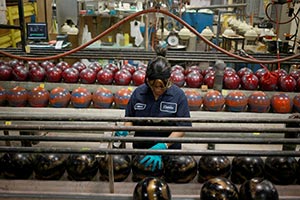Productivity Barely Rebounds After Earlier Slump

Worker productivity struggled to gain traction in the second quarter after slumping over the previous six months, leaving intact the diminished efficiency that’s defined the current U.S. economic expansion.
The measure of employee output per hour increased at a 1.3% annualized rate from April through June, after declines of 1.1% in the first quarter and 2.2% in the last three months of 2014, a Labor Department report showed Aug. 11. The median forecast in a Bloomberg News survey of 56 economists called for a 1.6% advance. Productivity grew 0.3% in the 12 months ended June.
“The story still is that productivity growth is historically very weak,” said Jim O’Sullivan chief U.S. economist at High Frequency Economics in Valhalla, New York, who projected a 1.2% gain.
A plunge in spending on new equipment during the recession and diminishing returns on investment in computers and software are among reasons productivity has slowed. Less efficiency limits how quickly the economy can grow without spurring inflation, adding another variable for Federal Reserve policymakers to consider in deciding when to raise interest rates.
“It explains why interest rates may only be raised very gradually,” Laura Rosner, a U.S. economist at BNP Paribas SA in New York, said before the report.
Economists’ estimates for productivity ranged from advances of 0.5% to 2.5%. The reading for the prior three months initially was reported as a drop of 3.1%.
The Labor Department issued revisions back to 2012 with the Aug. 11 report to reflect the updated readings on gross domestic product released by the Commerce Department last month.
Productivity grew 0.5% on average over the past three years, compared with a prior estimate of 0.9%. The update was centered in 2013, where efficiency was revised down to zero from the 0.9% previously estimated gain.
“We’re looking at a barely better than zero post-recession trend in labor productivity that doesn’t seem to be getting better yet this year,” Ted Wieseman, a Morgan Stanley economist based in New York, said in a note Aug 7. This makes some of the Fed’s long-run growth estimates “look questionable.”
The news on the cost side was less dismal. Expenses per worker increased at a 0.5% pace in the second quarter after a 2.3% increase in the previous three months that was much smaller than the 6.7% surge previously reported, the data showed.
Unit labor costs, which are adjusted for efficiency gains, were forecast to be little changed, according to the Bloomberg survey median. They climbed 2.1% in the year ended June.
The world’s largest economy started 2015 on a weak note, with GDP rising 2.3% in the second quarter after a 0.6% advance in the prior three months when temporary hurdles such as port delays weighed on activity, Commerce Department data showed July 30.
Policymakers, who have indicated they may begin lifting rates this year for the first time since 2006, have been watching trends in productivity and some have said they expect it to improve.
Slowing efficiency raises concern because it restrains economic growth from gaining momentum in the longer term. The pace at which an economy can expand without stoking inflation —which economists refer to as its speed limit — reflects the rate of growth of the labor force and how much each worker can produce.
Sustained weakness in productivity signals advances in GDP will be restrained in coming years. Economists attribute it to a host of reasons, including lack of adequate capital investment and a cooling pace of innovation.
While the debate rages on about measurement problems and the outlook for productivity, the persistent slowdown in recent years has more immediate implications for how far and how fast the Fed may raise the benchmark rate once they begin to tighten. It signals policymakers can begin raising rates sooner, with fewer increases in total.
Low productivity is a “serious problem” for the nation, former Fed Chairman Alan Greenspan said Aug. 10 in a Bloomberg Television interview.
During his years at the helm of the central bank, as productivity gains picked up between the late 1990s and early 2000s, Greenspan recognized accelerating worker efficiency would contain inflation even as the economy strengthened and unemployment stayed low. The realization allowed the Fed to keep interest rates little changed from 1996 to 1999.
Slowing productivity also may put pressure on corporate profits. Over time, businesses facing an earnings threat may be less inclined to sustain the strong pace of hiring the economy has seen this year. Payrolls grew by 215,000 workers in July after a 231,000 gain in June, and the jobless rate held at a seven-year low of 5.3% last month.

